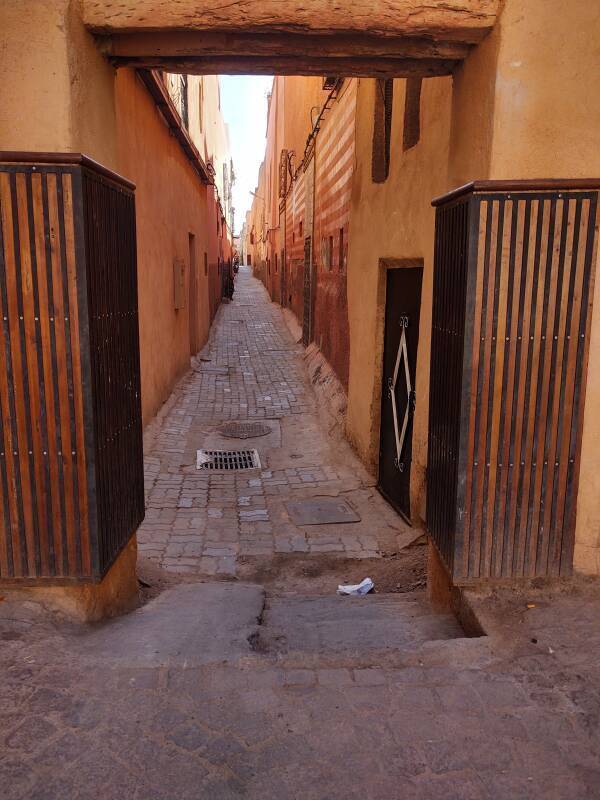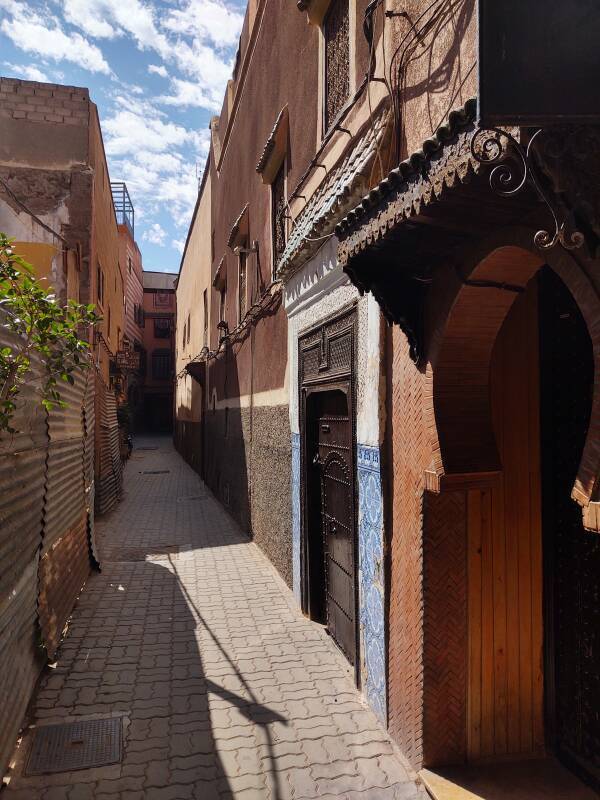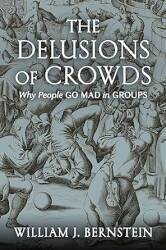
Saadian Tombs
A Royal Necropolis in Marrakech
The Saadian Tombs, locally labeled
Tombeaux Saadiens,
date back to that dynasty of 1510–1659,
especially to the 1578–1603 reign of
the sultan Ahmad al-Mansur.
Many art historians point to this tomb complex as the
high point of Moroccan architecture during this period.
The tilework and carved walls and ceilings are beautiful,
with an overwhelming amount of detail.
The tombs became isolated from the surrounding neighborhood,
to the point that they were considered to be "rediscovered"
in 1917.
Now they're a major attraction in Marrakech,
both for foreign visitors and for Moroccans.
The tomb complex is within the royal kasbah or fortified
citadel, built against the south side of the Kasbah Mosque.
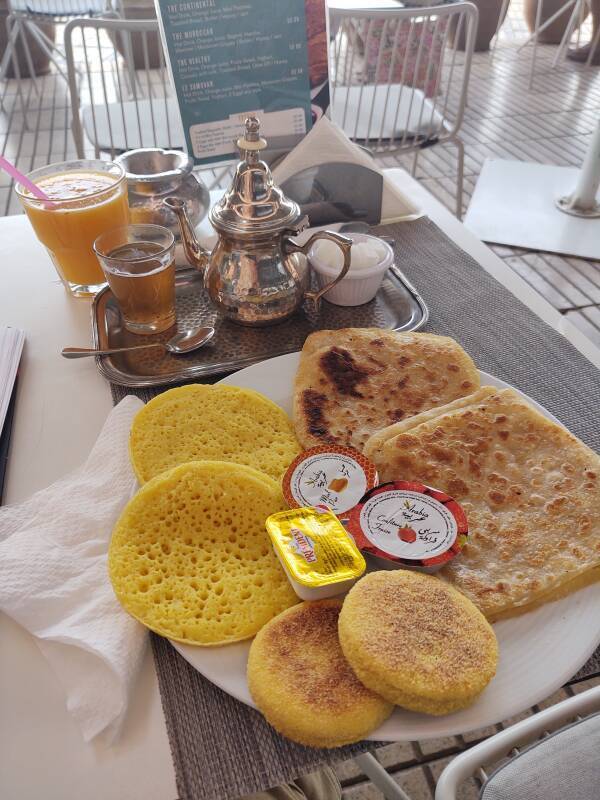
Starting the Day
I started the day with breakfast at a café just off Jemaa el-Fnaa. A typical Moroccan breakfast carries me through the whole day, skipping lunch with just some tea in the afternoon before dinner. Moroccan food is good, it's just that there's too much of it.
It was a walk of just a kilometer to the Saadian Tombs from where I was staying within the medina at the Hôtel Atlas. I would need lots more walking after all that breakfast.
Allow plenty of time to visit the Saadian Tombs.
It's a popular attraction. Visitors arrive by the bus load. Only one or two people at a time can view the Hall of Twelve Columns, a chamber with a great deal of detail. So, you will have to stand in line.
With plenty of time, you can visit the components in any order. You can sit down and wait for the lines to subside. And, as I did, you can return to the Hall of Twelve Columns for another look. That is, if you are free to spend as much time as you would like.
Toward the Tombs
I walked south along Rue Oqba Ben Nafaa, just outside the west edge of the medina. Excellent, not at all touristy.
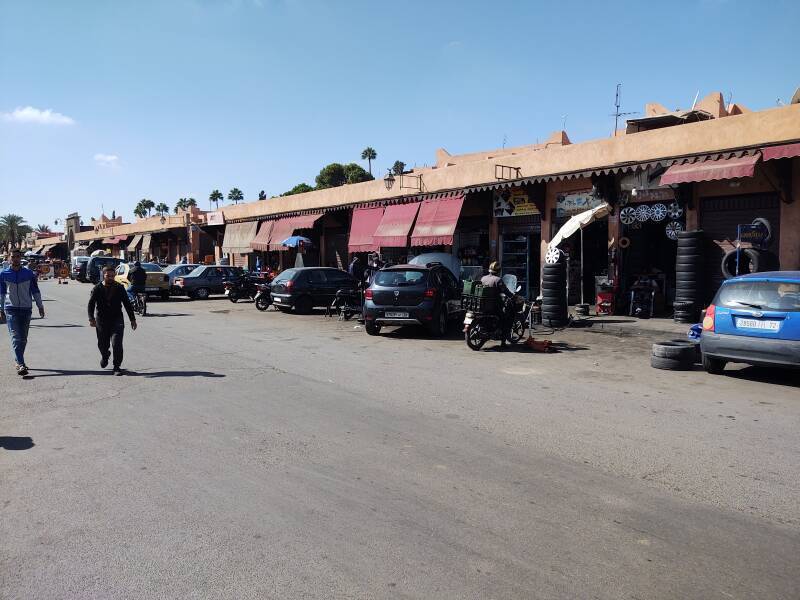
I passed a series of automobile and motorcycle repair shops and saw where the local people bought parts and had repairs done.
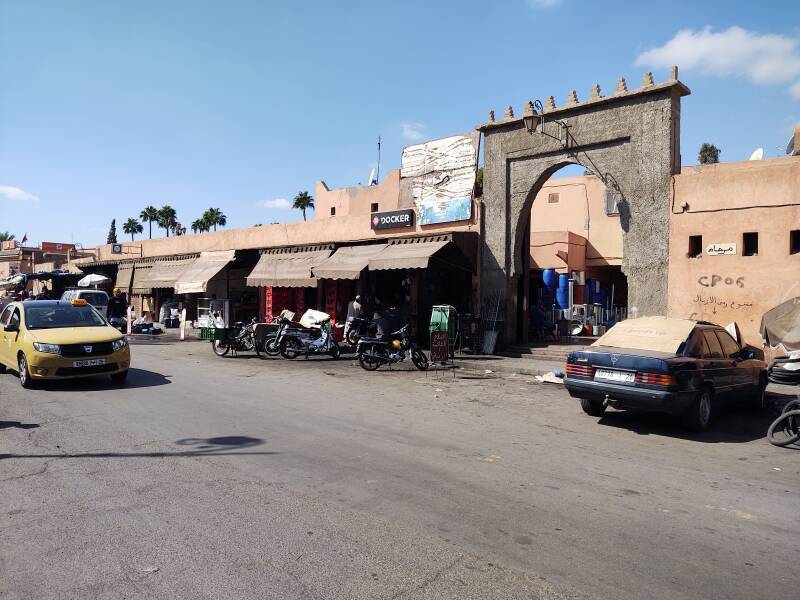
Bab Agnaou
That led to Bab Agnaou. It was built around 1188–1190 under the direction of the Almohad caliph Abu Yusuf Ya'qub al-Mansur.
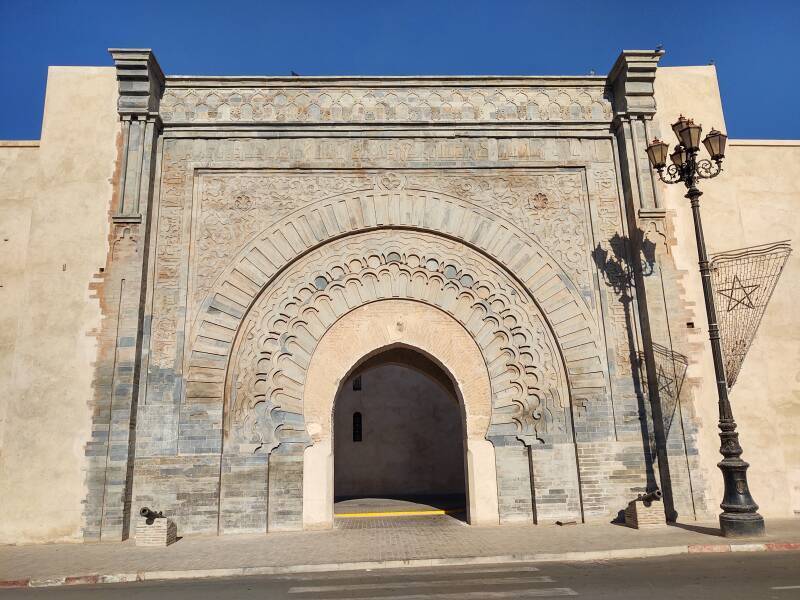
Bab is Arabic for "gate" or "door". As for the meaning of "Agnaou", possibilities include "mutes", "Black people", and "sheep without horns". Let's just concede that no one really knows.
Alternative names for the gate include Bab al-Qasr or "Gate of the Palace", and Bab al-Kuhl or "Gate of Kohl", which seem to be pretty straightforward. There might once have been a cluster of shops here selling kohl, ancient mascara. And, Bab al-Qasr or "Gate of the Palace" definitely makes sense, because this was the main gate through the fortified walls of the royal kasbah.
A kasbah is a citadel, frequently found nested within a city's fortified walls, as this one was. This gate used to be an even more secure bent gate, as you had to turn 90° to the right and then 90° to the left immediately after entering it.
Some of the interior of the kasbah is now opened up to the point that cars and delivery vehicles can easily pass in and out through a wider straight-through gate recently added to the right of Bab Agnaou.
Entering the Saadian Tombs

The entrance to the Saadian Tombs is at the end of the light yellow structure, beyond the taxi.
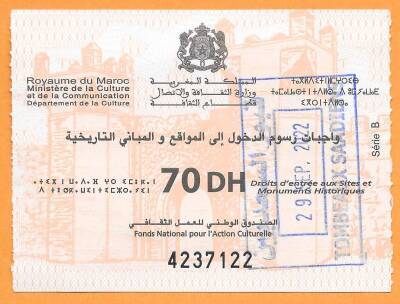
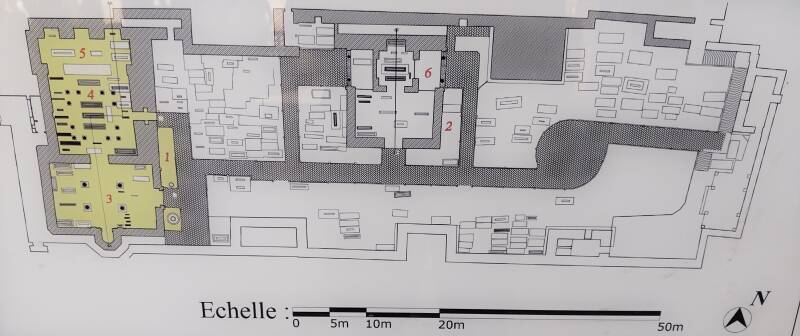
Plan of the Saadian Tombs
Left (1, 3, 4, 5): Western Sanctuary
Center (2, 6): Eastern Sanctuary
3: Mihrab hall
4: Hall of 12 Columns
5: Hall of 3 Niches
6: Dome of Lalla Mas'uda
Eastern Sanctuary
A bus or maybe two had just arrived, so there were long lines to see into the Western Sanctuary halls. I was in no hurry, I would look at the Eastern Sanctuary first.
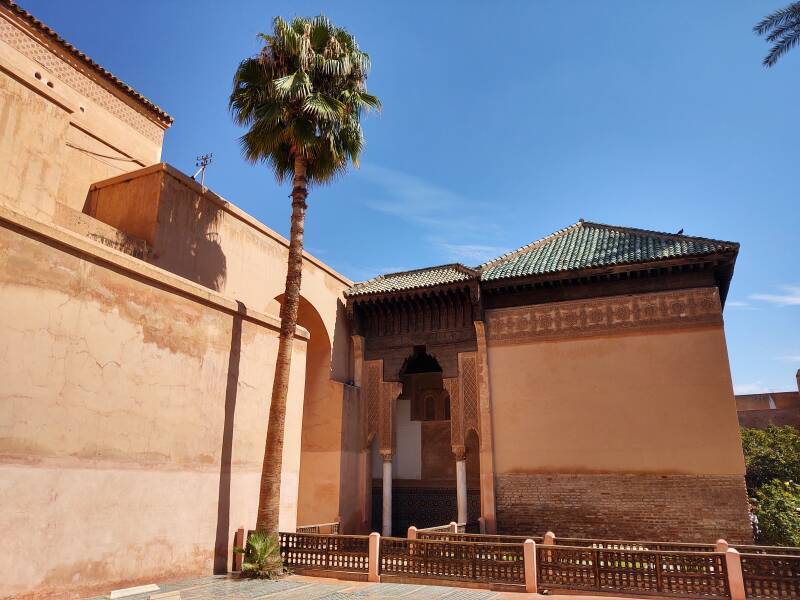
It actually makes more sense to start the way I did, as the Eastern Sanctuary was built first. The wall of the Kasbah Mosque fills the left half of the above picture. In particular, it's the qibla wall, the wall with the mihrab, the niche indicating the direction of prayer. Not toward the mihrab itself, but perpendicular toward the wall in which it is built.
Nowadays the qibla is defined as the local direction toward the Ka'aba, the roughly cubical black stone structure in Mecca that is the most holy site in Islam. That requires spherical geometry, which was no problem for the Islamic world. The Greek astronomer and mathematician Autolycus of Pitane had written his book On the Rotating Sphere in the late fourth century BCE. Then the Islamic mathematician Ibn Mu'ādh al-Jayyānī (989–1079) wrote The Book of Unknown Arcs of a Sphere in the mid 11th century CE. It's the first known work on the modern form of spherical geometry. Meanwhile, Europeans were struggling to do addition in Roman numerals.
However, in the early centuries of Islam in Morocco, mosques were being built with a different plan.
A ḥadīth records Muhammad saying that Muslims should pray "like this", describing facing toward the south. So, everyone faced south to pray. Mosques were built with their qibla wall toward the south.
Later, that ḥadīth was re-interpreted in light of Muhammad having been in Medina, north of Mecca, when he said that. The new thinking was that he must have meant "facing toward Mecca", and specifically toward the Ka'aba, and not "facing south" no matter where you are.
Early mosques in Morocco were built with the qibla to the south. The standard alignment slowly rotated toward today's correct orientation of 91° in Marrakech over the centuries. This complex was mostly built in the late 16th century when Moroccan mosques were aligned south or slightly southeast.
There are loggias on the west and east sides of the Eastern Sanctuary.

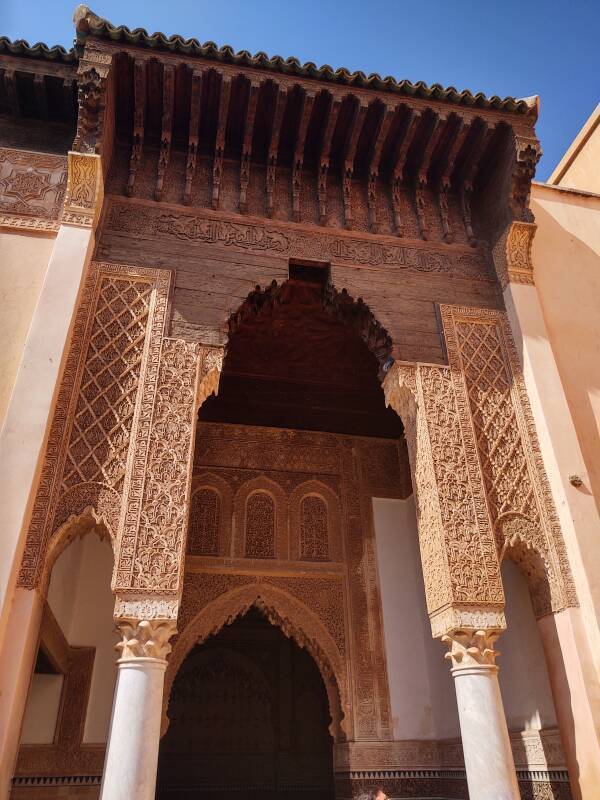
The loggias have triple arches — the cedar wood canopy at the top rests on pillars covered in carved stucco, which in turn rest on marble columns. Smaller lambrequin arches with elaborate muqurna patterns of lobes and points join the pillars to the walls.
The entire Eastern Sanctuary is also known as the Domed Tomb of Lalla Mas'uda, who was also known as Mas'uda al-Wizkitiya. She was the wife of Muhammed al-Shaykh, the first Saadian Sultan. This archway within the east loggia leads to her tomb.
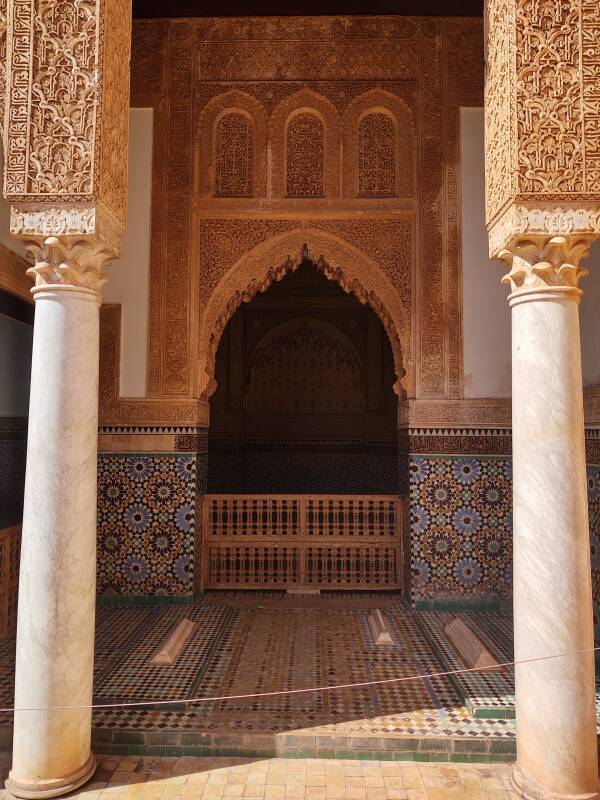
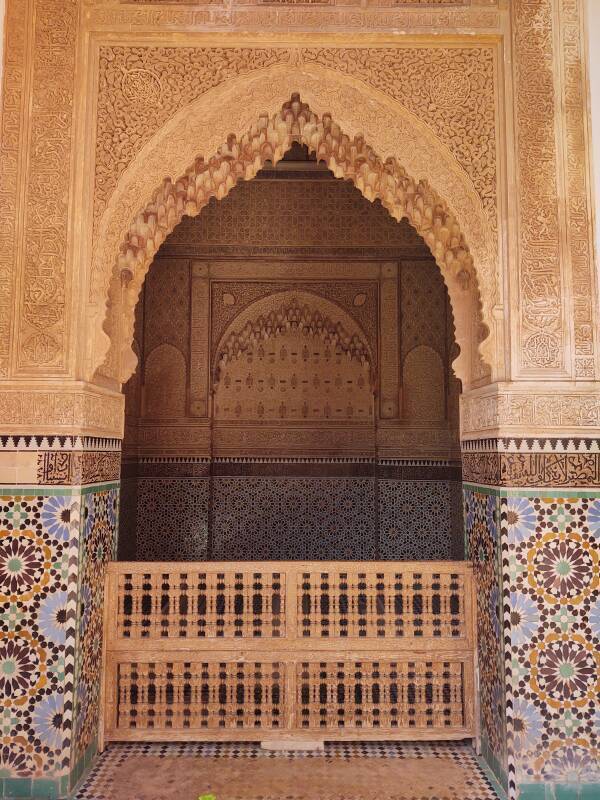
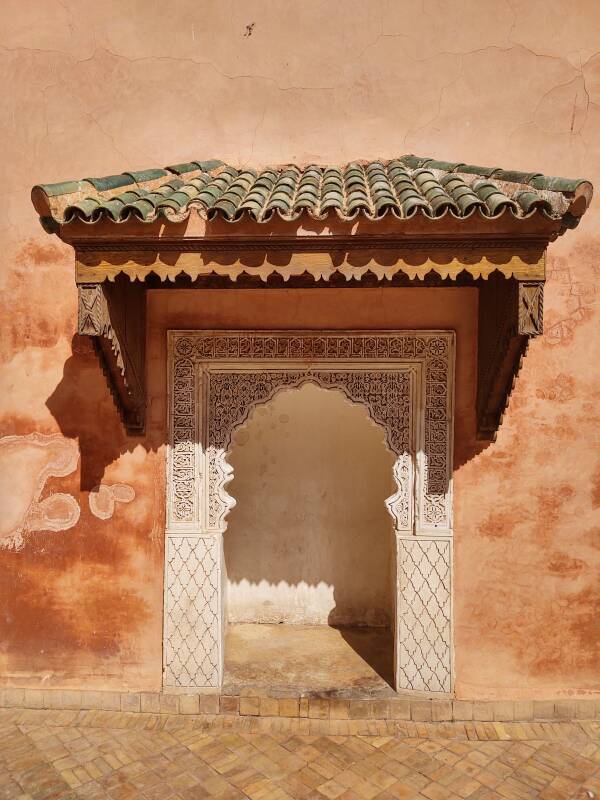
Both the west and east loggias connect to the central half of the East Sanctuary.
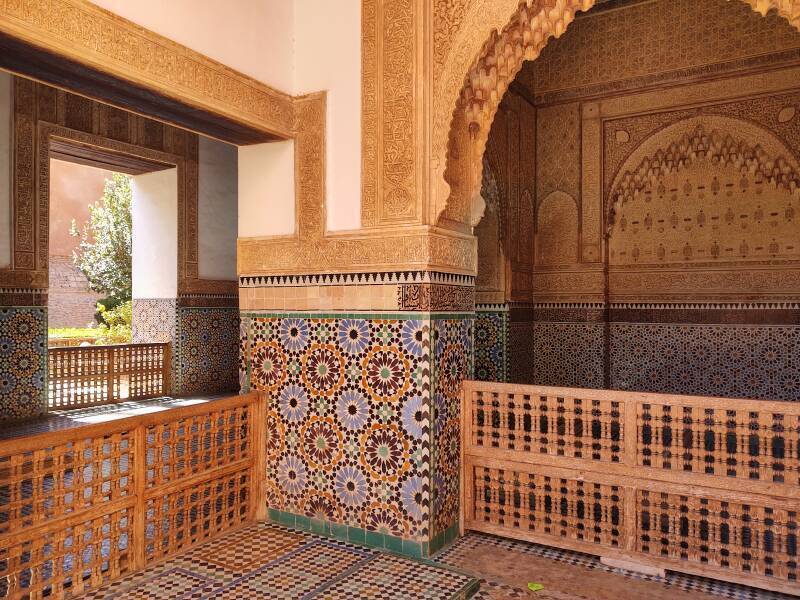
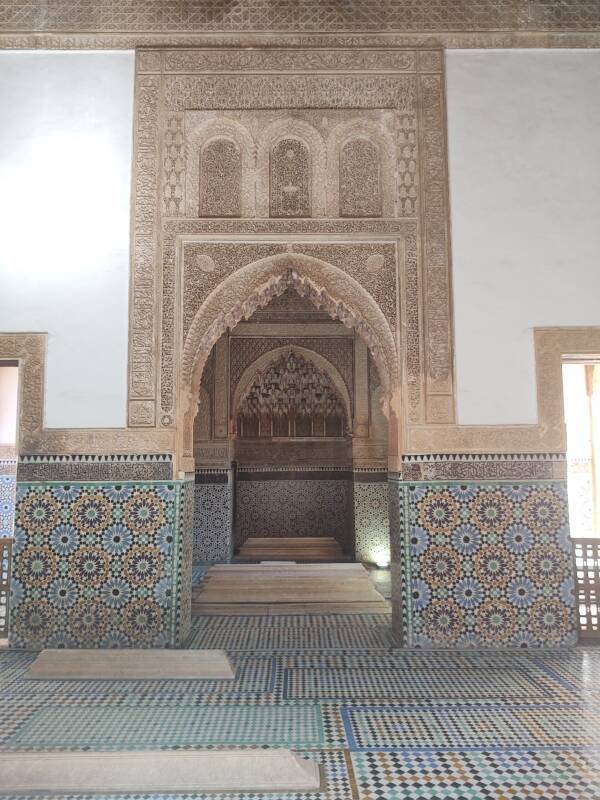
From the central chamber you can look across the grave of Muhammed al-Shaykh, the first Saadian Sultan, to that of Lalla Mas'uda, his wife.
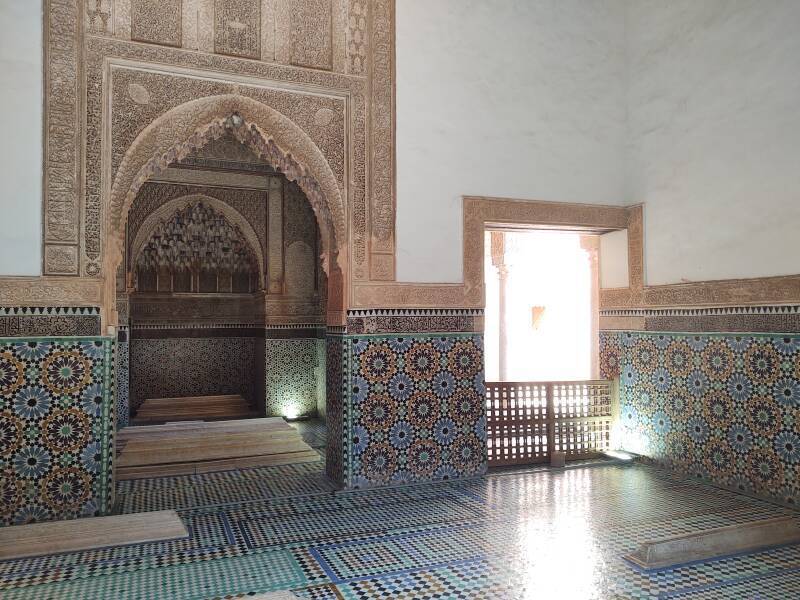
The Western Loggia is similarly decorated.
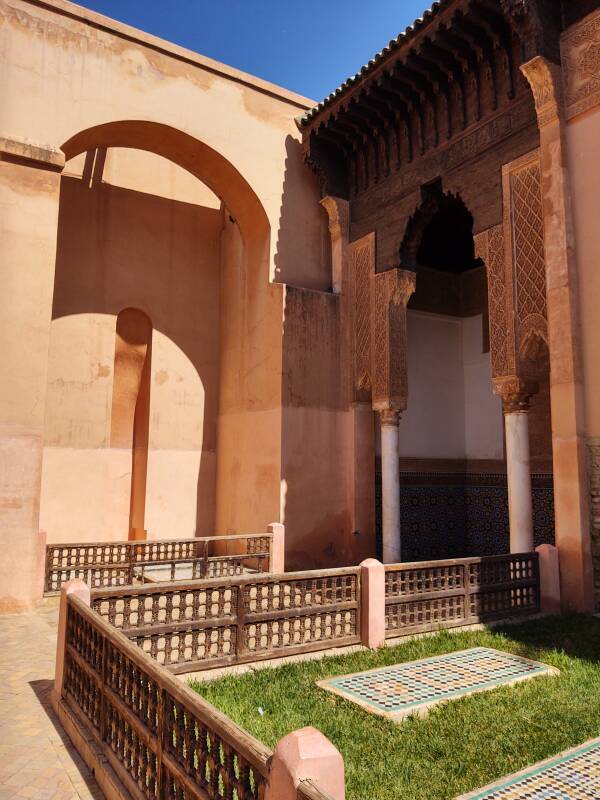
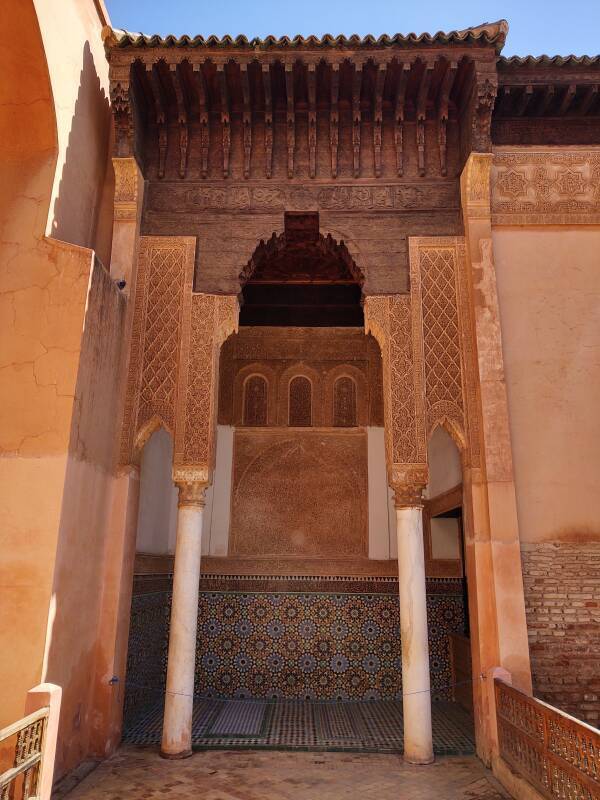
Both loggias have elaborately carved cedar wood ceilings.
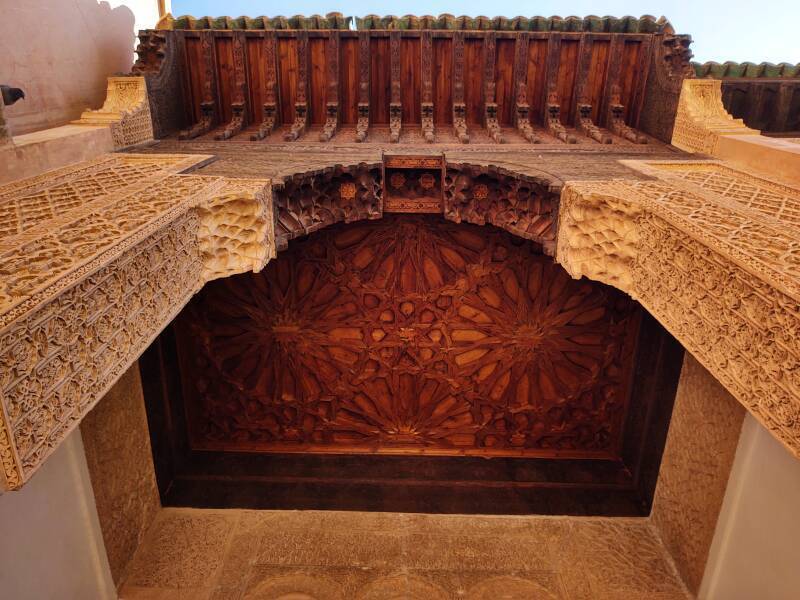
The West Loggia connects to the central chamber only.
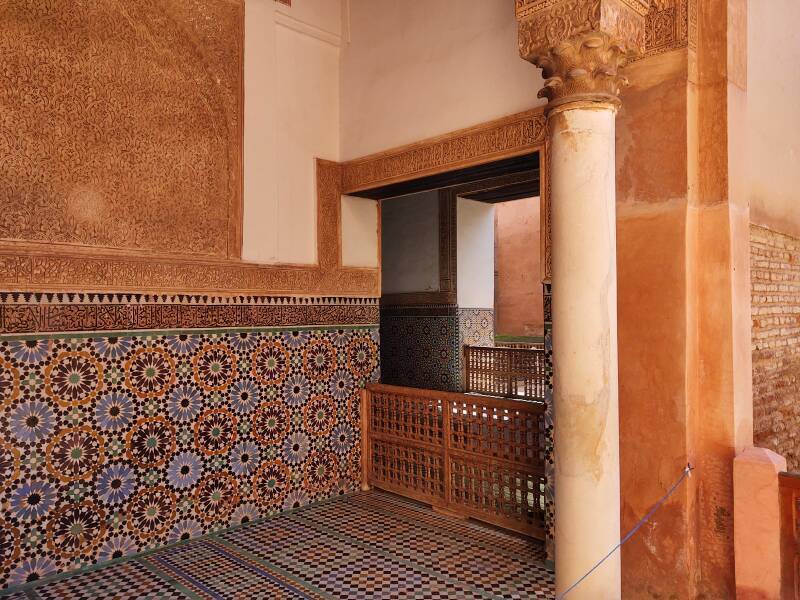
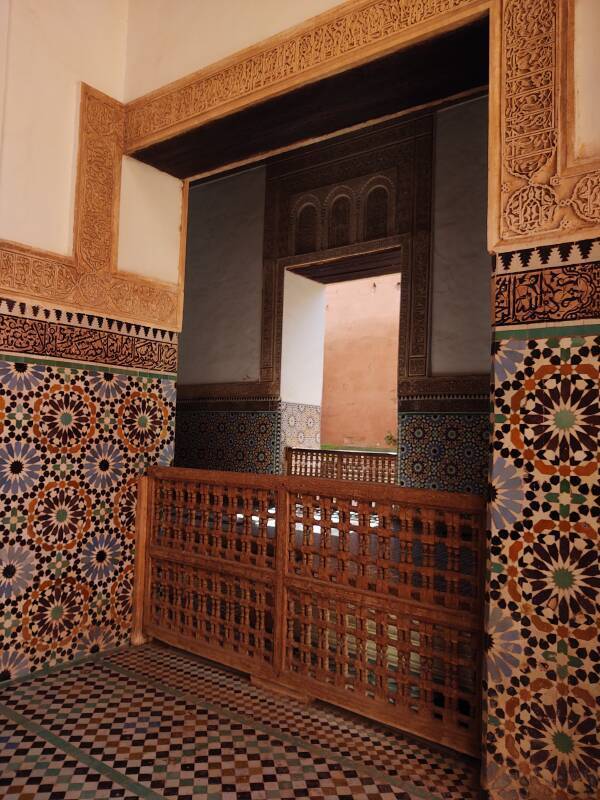
Western Sanctuary
I kept an eye on the lines at the Western Sanctuary, which was added to the complex some time around 1600 CE. Here you see a long line of people waiting to look into the Hall of Twelve Columns.
To the left of that is a door into the Mihrab Hall.
And to the left of that, back in the corner, is the small door through which you enter the tomb complex.

The tomb complex continued to be used. Prominent figures were buried within the Western Sanctuary as late as 1655. Those tiled rectangles you see above are individual graves added later.
Moulay Isma'ilin Meknès
The Alaouite dynasty sultan Moulay Isma'il, ruling from Meknès in 1672–1727, plundered the Saadian dynasty palaces. He closed this complex off from surrounding buildings, but it continued to be used for the tombstones you see in the open garden today.
But the tomb complex eventually became so closed off that it wasn't used at all. It wasn't really forgotten, just ignored. The Service des Beaux-Arts, Antiquités et Monuments historiques, founded in 1912 as the French Protectorate took control of Morocco, "rediscovered" the Saadian Tombs and began a careful restoration process in 1917. Scholars began to study it, and the public was first allowed to visit it.
Western Sanctuary — Mihrab Hall
The lines went down and I went to the Mihrab Hall. There's the mihrab, the niche indicating the qibla or direction of prayer, on the wall to the left as you look in.
The rectangular tiled areas on the floor are graves of Alaouite dynasty family members. A few have low triangular tombstones.
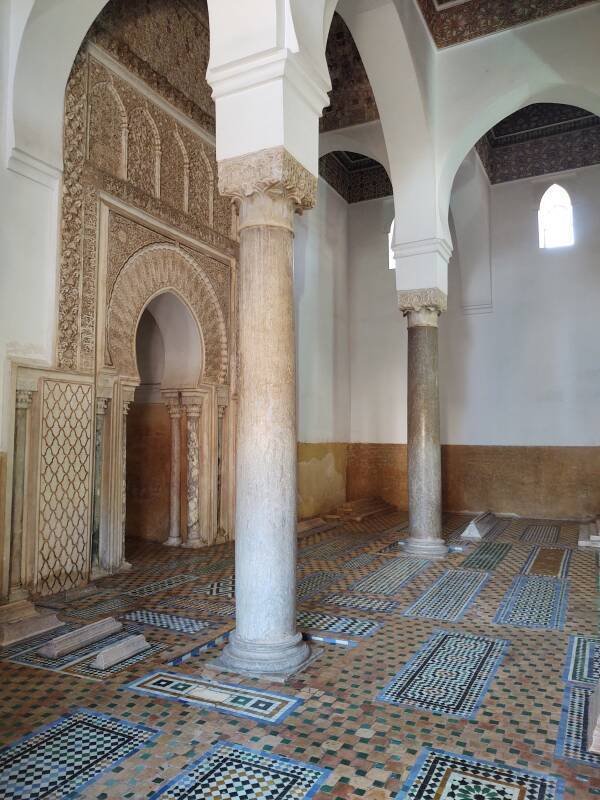
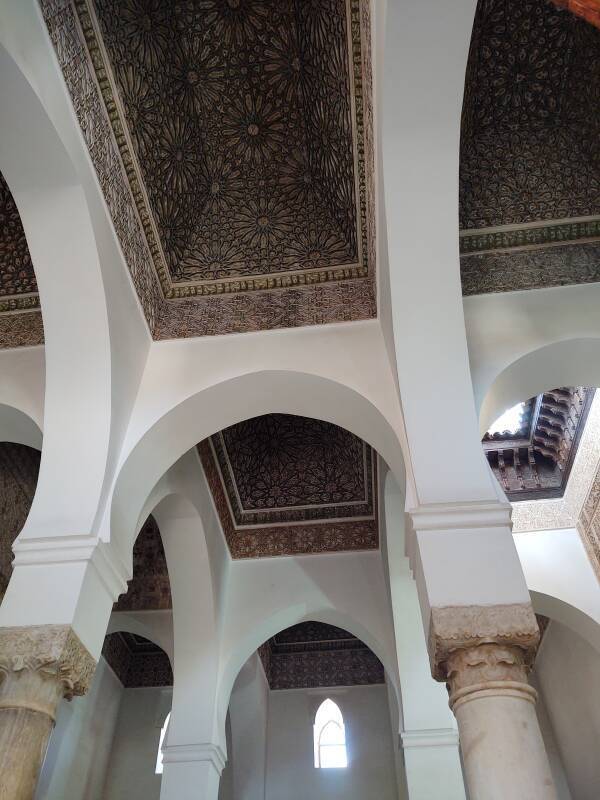
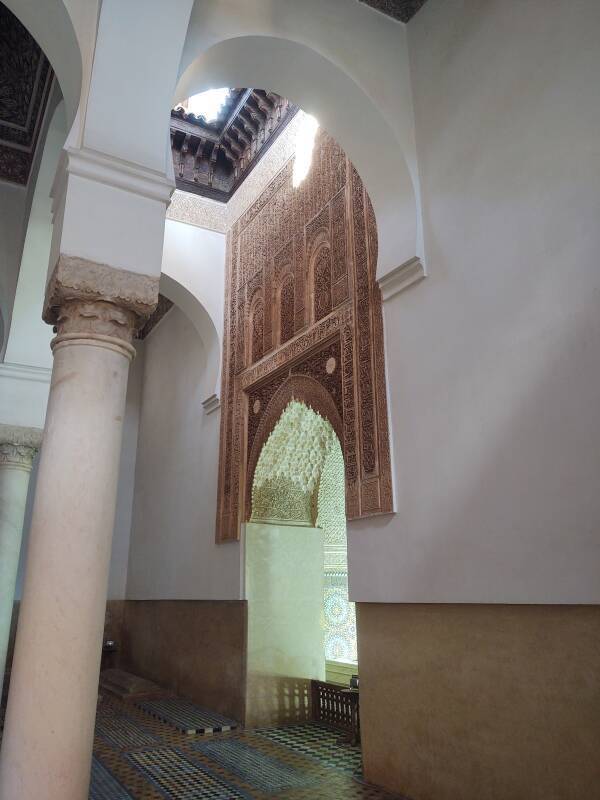
The door seen above is opposite the mihrab, and connects the Mihrab Hall to the Hall of Twelve Columns.
This grave surrounded by a wooden railing is thought, at least by some, to be that of the Alaouite sultan Moulay al-Yazid, who died in 1792.
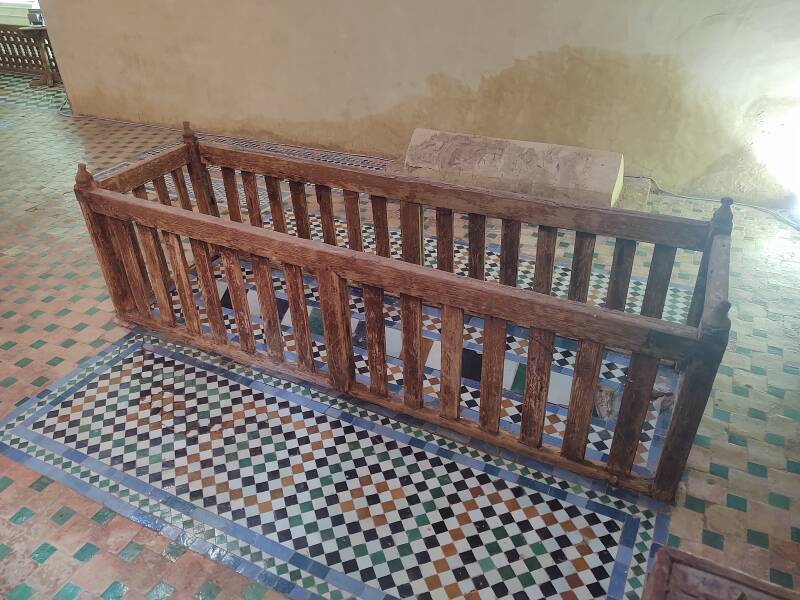
Western Sanctuary — Hall of Twelve Columns
Finally, to the Hall of Twelve Columns, the most elaborately decorated part of the Saadian Tombs.
Originally, the Mihrab Hall was the only entrance to the Western Sanctuary. With the Alaouite dynasty having used it as a mausoleum, with its floor filled with graves, a small entryway was cut into the center of the east wall of the Hall of Twelve Columns. Two people can squeeze into the inner end of it and look into the hall.
The grave in the center is that of Ahmad al-Mansur, the Saadi sultan of Morocco 1578–1603. He was very well educated and became a powerful figure in European politics. He developed friendly relations with England and sent an ambassador to Queen Elizabeth's court, he had French physicians in his court, and he wrote in 1601 of his desire to colonize the Americas, settle it with Moroccans, and wait for the Mahdi or Islamic messiah to appear. In Africa he took control of the trans-Sahara gold trade and seized control, at least briefly, of the Songhai Empire spanning much of today's Mali and Mauritania. And, an enlightened man, he issued a fatwa discouraging the use of tobacco.
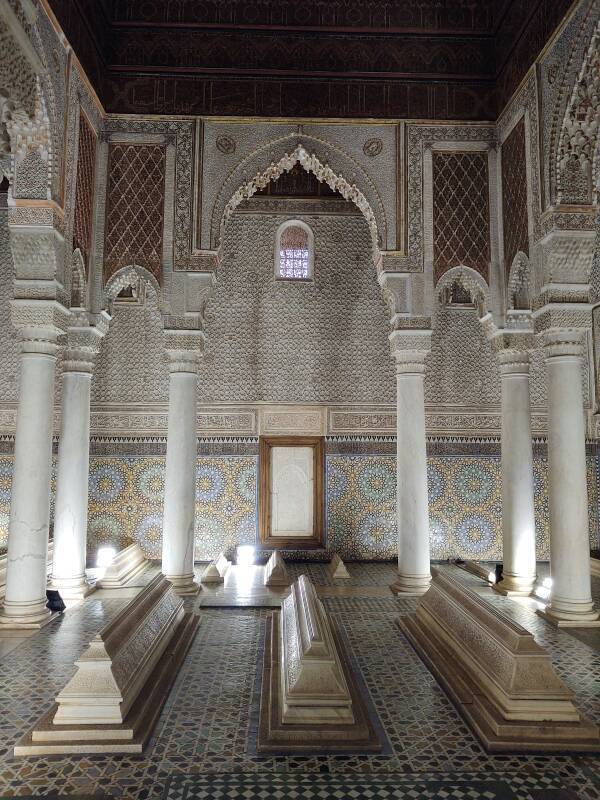
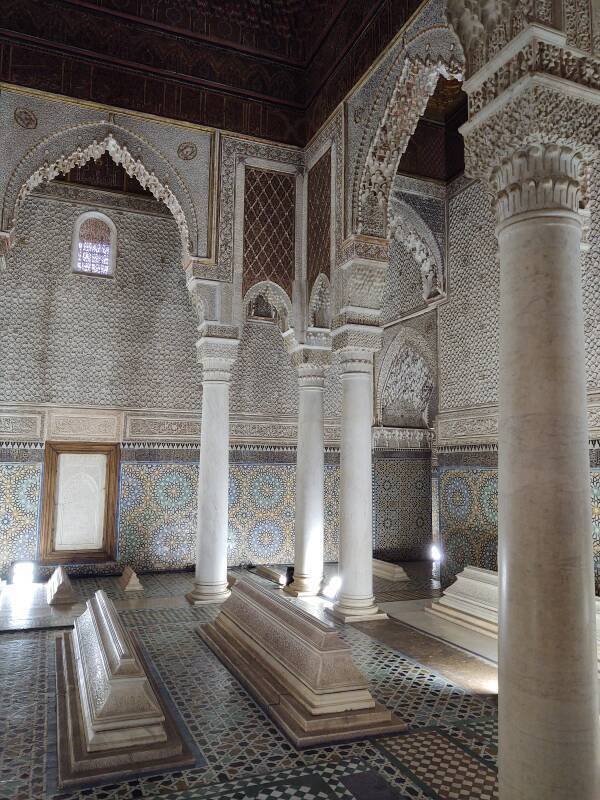
It's a square chamber about 10 meters on a side and 12 meters high. Within that square is a smaller square formed by twelve columns of marble in groups of three at the corners.
The columns support muqurna arches.
The walls have zellij tilework in complex patterns up to eye level, then carved stucco above that.
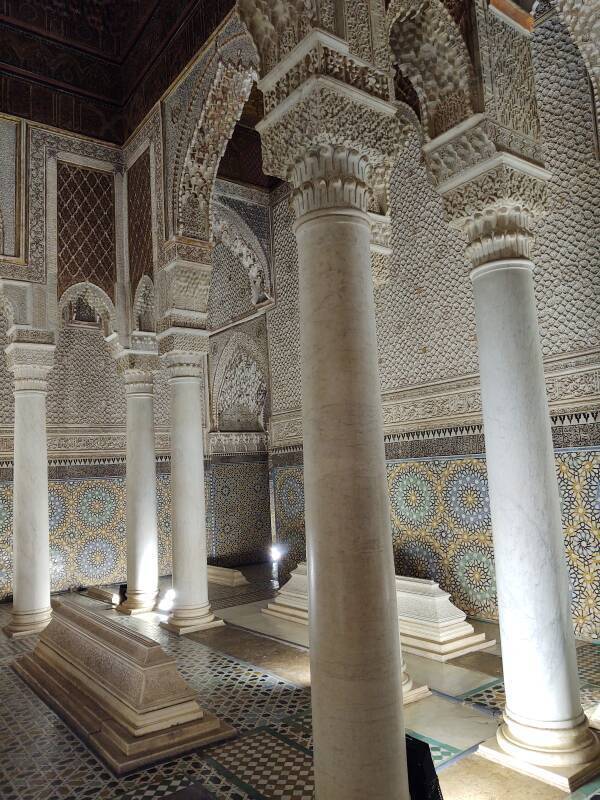
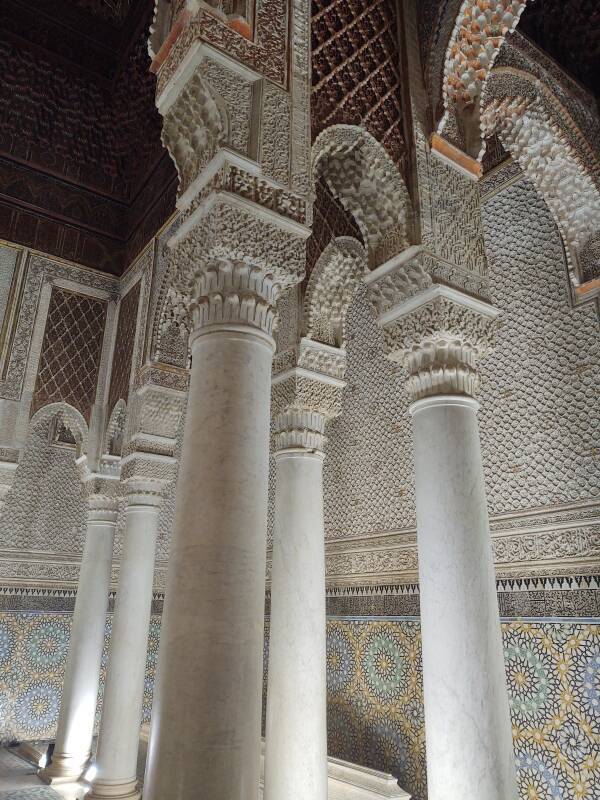
There is one large square ceiling at the center, and eight smaller square and rectangular ceilings around it. All are filled with elaborately carved cedar.
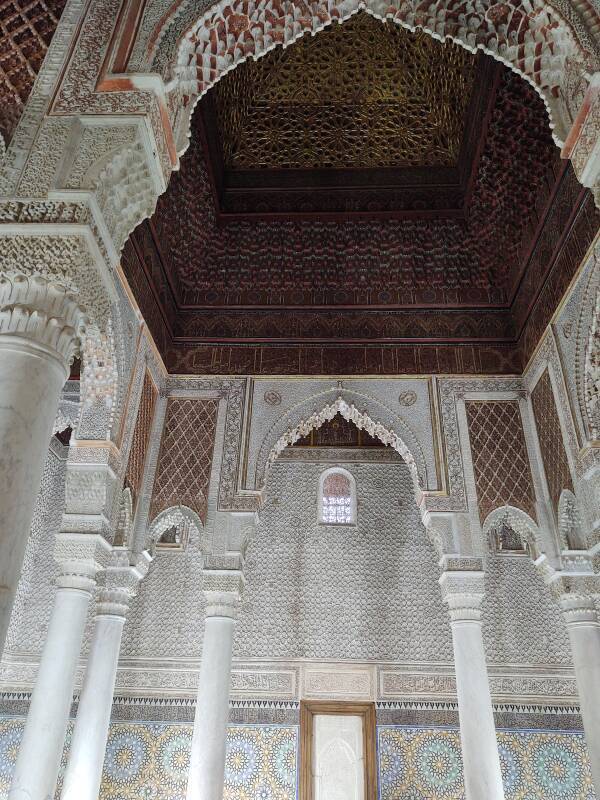

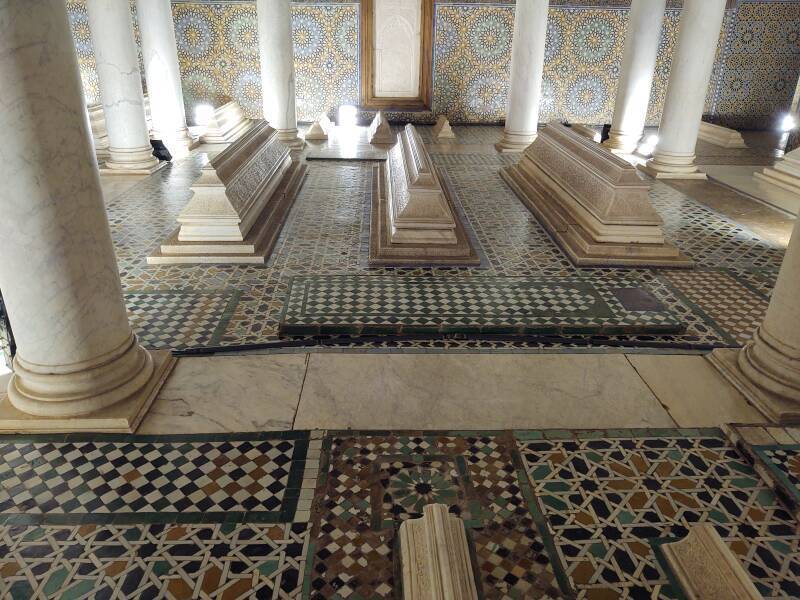

Western Sanctuary — Hall of Three Niches
The Hall of Three Niches is off to your right as you look in. You can see it through an arched door connecting it to the Hall of Twelve Columns. That's one of its three niches at the back here.
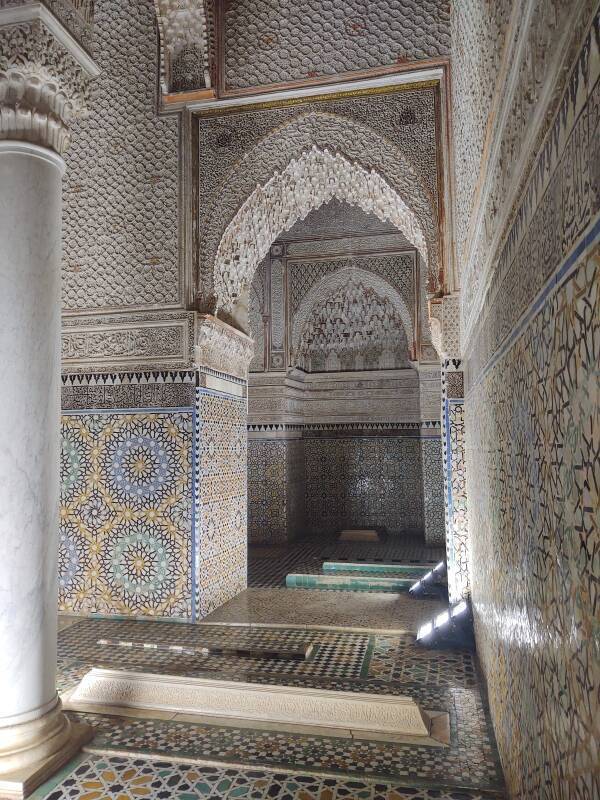
Through the Neighborhood
The Kasbah Mosque was built probably starting in 1185 CE under the direction of the Almohad Caliph Yaqub al-Mansour, and it was finished by 1190. That was about 400 years before the Saadian Tombs were built against its south side.
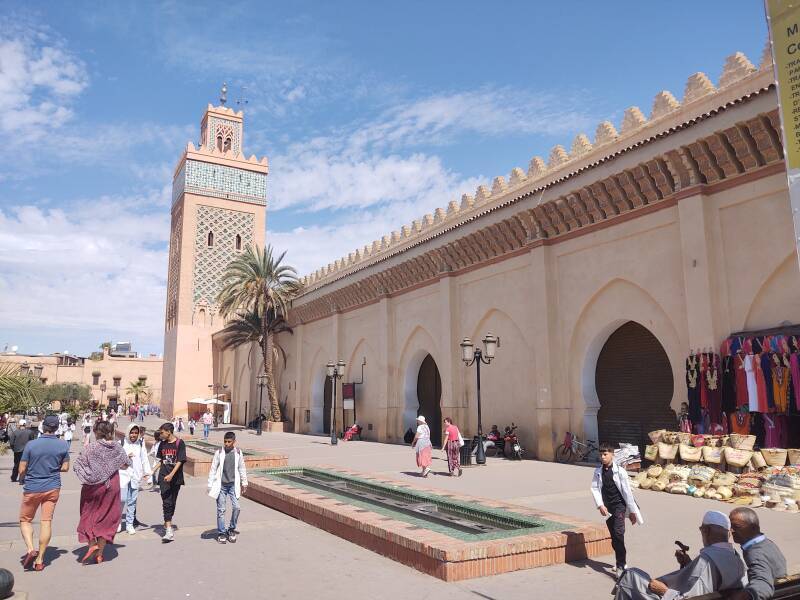
I got lunch at a nearby café — grilled chicken, salad, and fries.
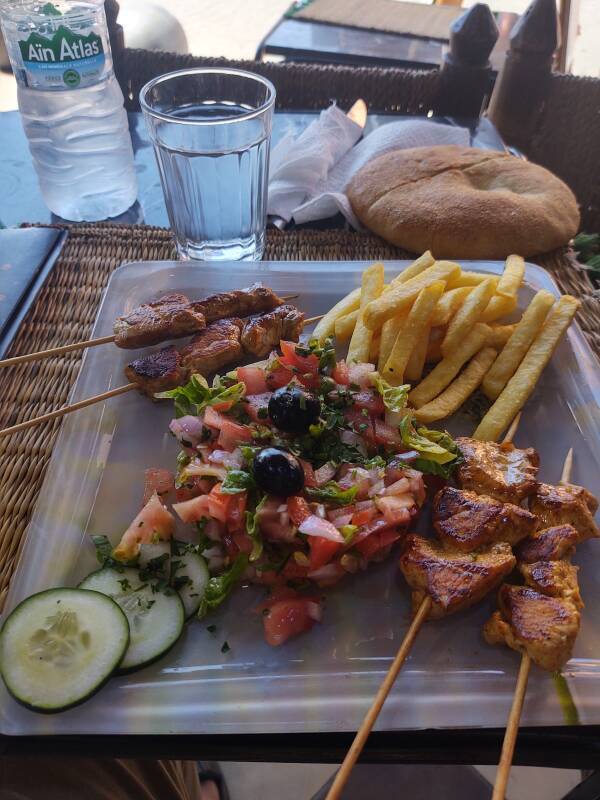
My seat provided a good view of the motor vehicle traffic making its way through a tight passageway with sharp turns.
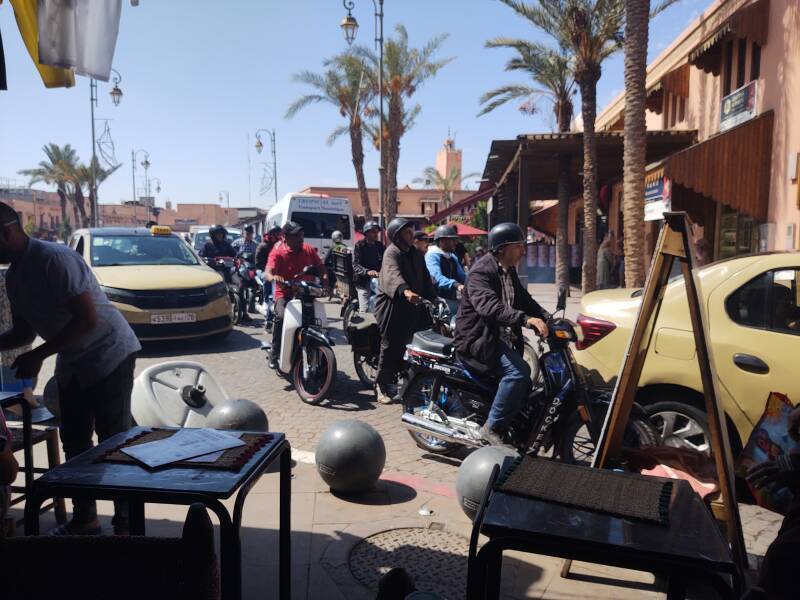
Walking further east, I passed along and through further walls.
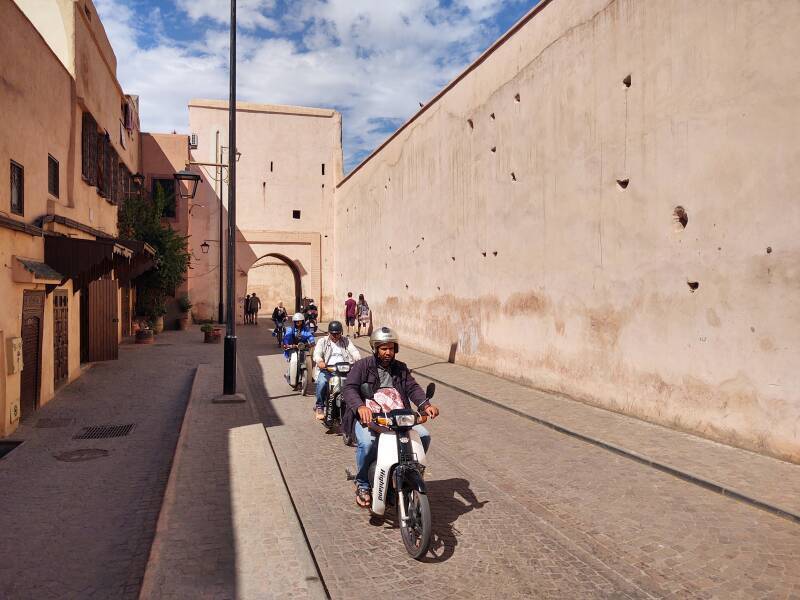
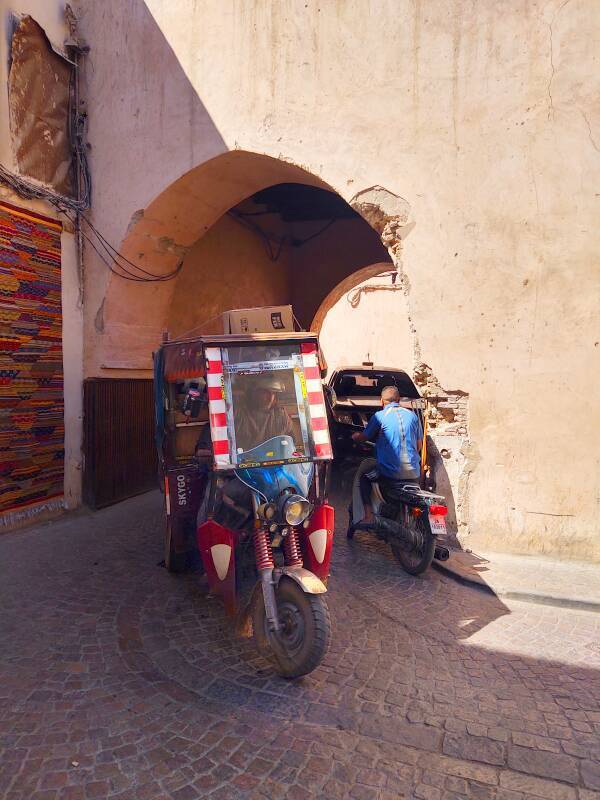
Beyond that was the mellah, the old Jewish quarter of Marrakech.
Almost every time someone in Morocco asked me where I was from and I said "the United States", they immediately started telling me how to find the local sites of Jewish heritage. They seem to think that all Americans either are Jewish, or are fixated on Jewish matters. Only about 1.2% of Americans are religiously observant Jews, while about 1.1% are Muslims.
There's a convincing argument that much of U.S. foreign policy since World War II has been hijacked by a conservative obsession with the "Rapture" concept, which was dreamed up in the U.S. in the late 19th century. Get the Jews to Israel, convert them to Christianity, and bring about the End Times, the destruction of the world. There's nothing about that in the Bible, and it tends toward elaborate revenge fantasies, so there's the usual abuse of the word "conservative". But it's something for which the U.S. is known. See The Delusions of Crowds for details.
